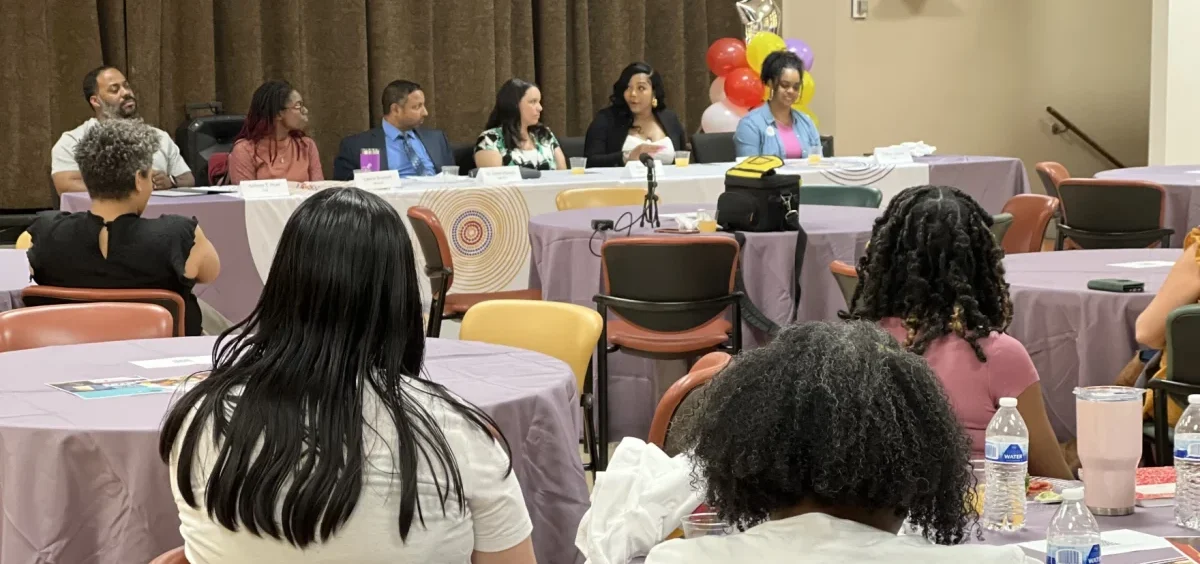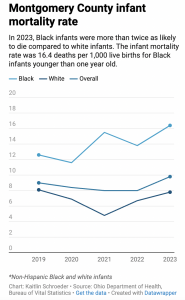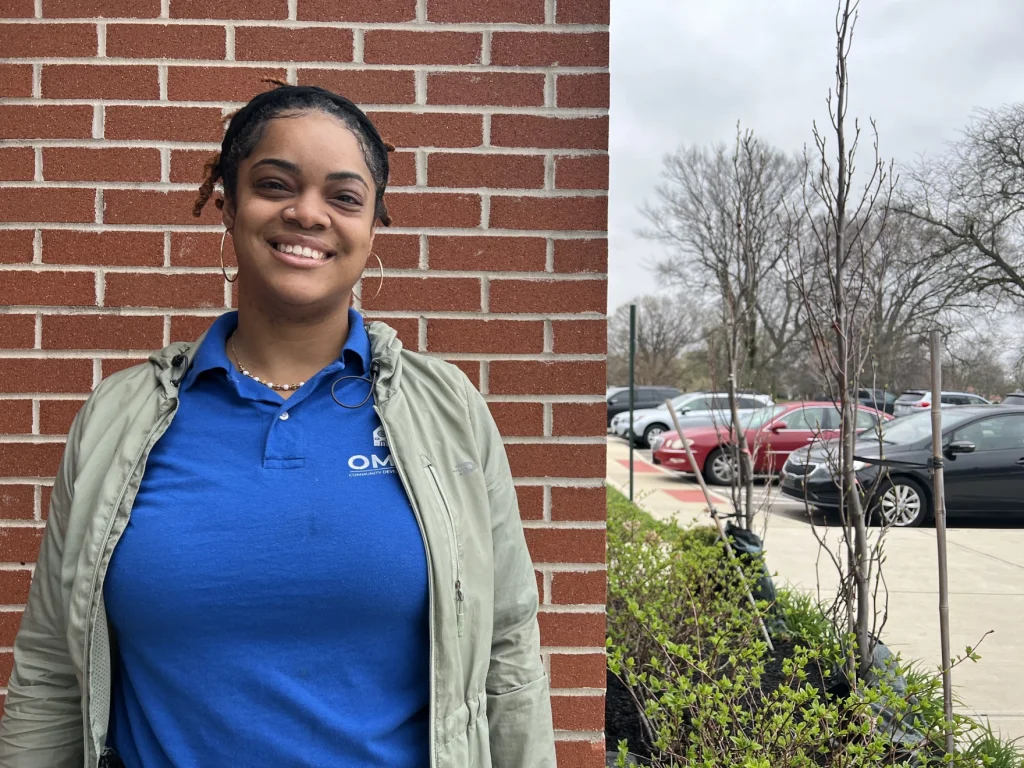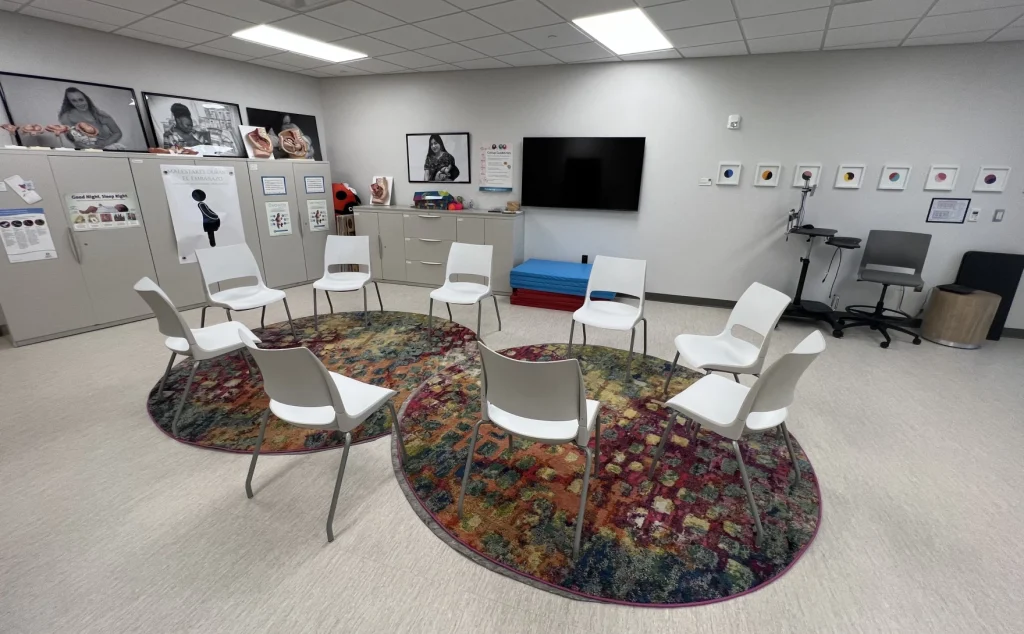News

Black maternal mortality and infant mortality is persistently high — but overwhelmingly preventable
By: Ngozi Cole | WYSO
Posted on:
DAYTON, Ohio (WYSO) — When Diamond Smith gave birth to her child in Dayton, her experience was traumatic. Her previous pregnancies had gone fairly well, but this time, the 30-year-old mom felt like her concerns and needs weren’t taken seriously by her doctors, nurses and hospital staff.
“You know how they say the statistics of white women get treated differently than Black women? Like, they really treated me like the bottom of the charts,” Smith said. “It was just bad. I was in pain. I was crying.”
She recalled a particular prenatal visit when she tried to explain her heartburn to nurses and asked for help.
“I’m throwing up blood,” she said. “It was so bad. I asked them, ‘well what can I do?’ (They said) ‘oh, nothing, you just gotta keep trying.'”
Smith thinks she and her now one-year-old son barely survived the childbirth experience.
“After I had him, every time I talked about what happened I would cry, because it was that emotional,” she said. “Like, I would never wish it on nobody.”
Maternal mortality is a persistent threat to Black women and babies
 Black women in the U.S., like Smith, die three times more often than white women from pregnancy related causes, according to the CDC.
Black women in the U.S., like Smith, die three times more often than white women from pregnancy related causes, according to the CDC.
Ohio is currently ranked one of the worst states for maternal mortality and infant deaths, and Black parents and babies are at even higher risk.
State data also shows that more Black women are dying from pregnancy related causes than white women. From 2008-2016, there were 30 deaths per 100,000 live births for Black women, compared to 12 deaths for white women.
Montgomery County is among the worst in Ohio for maternal and infant deaths, according to a 2023 study by Harman, Reisinger-Kindle and Maxwell at Wright State University’s Boonshoft School of Medicine. The study compared maternal and infant deaths across three zip codes in the county. The mortality rate for Black women and babies were consistently worse, compared to other races.
Montgomery County public health data also shows that over the past three years, the rate of Black infant deaths has gone up. The rate of white babies dying has fluctuated, but always been below the county’s average numbers.
Dr. Shawnita Sealy-Jefferson runs a research lab at Ohio State University where she looks into racial discrimination and health access within the U.S health system.
“What’s behind the high numbers of poor maternal and infant health — where in which Black mothers and infants do worse and they die unnecessarily — is structural and institutional racism,” Sealy-Jefferson said.
Some experts within the Dayton health care system, like Dr. David Dhanraj, agree.
Dhanraj, who now heads the OB GYN department at Wright State University, was part of a project addressing maternal and infant deaths in neighboring Cincinnati. During the program, medical experts tried out different methods to address high rates there too.
“We were going to do all these things. It was safe sleep. It was smoking cessation etc. And we saw some drop in infant mortality,” he said. But the disparity remained. “So that’s when I said, okay, we really got to address the elephant in the room.”
Dhanraj, like Sealy-Jefferson, thinks change can only happen when providers address bias and prejudice when delivering care.
“We’re not going to escape the numbers. Just ignoring or saying, ‘we can’t talk about it’ … we’re still going to have high levels of disparities.”
Smith’s experience echoes that of other Black women who believe that their health concerns aren’t taken seriously. She credits her doula, DeShae Jackson, for being with her through her experience navigating the health care system during pregnancy.
“Just her presence and her just being there, period,” Smith said.
Smith met Jackson through a community support program Omega Community Development Center, a nonprofit in Dayton.

“I felt like nobody believed that she was in pain all the times she would go to the hospital,” Jackson said.
For Jackson, a perfect scenario would be where the patient’s concerns are listened to.
“Just believing what the mother says first, regardless of how you feel, whether you think she’s lying or not,” she said.
Advocates like Gayle Fowler, an environmental health researcher from Dayton, wants to see the health and medical industry engage better with families.
Fowler has been researching the cause of health disparities, including maternal mortality for Black people in the Dayton area, for more than ten years.
“I believe that at the heart of this issue as well is believing Black women and validating their voice,” Fowler said.
Sarah Hackenbracht, the CEO of the Greater Dayton Hospital Association, acknowledges that the health care industry should confront bias.
“There’s an ongoing education opportunity for all health care partners and providers, no matter whether it’s someone providing maternal and infant services, if it’s a pediatrician — that cultural competency is absolutely critical,” she said.
Public health researchers look for solutions
To address structural racism in health care, public health researchers say solutions have to be comprehensive.
“We have to be tackling issues of racism. We have to be tackling issues of economic injustice. We have to be tackling income inequality,” said Dr. Zinzi Bailey, a health inequality researcher from the University of Maryland’s School of Public Health.

That means more than just medical care. As part of the Healthy Start program, community health workers also support families, including helping parents apply for jobs and giving families essentials like free diapers and car seats.
“They are what we call barrier busters,” said Five Rivers Health Centers CEO Gina McFarlane-El. “They’re trying to figure out a way to help that mom so they’re not stressed out about whatever is going on at home.”
Five Rivers also works with Ebenezer Healthcare, a local organization supporting newly arrived immigrants to navigate Dayton’s health care system. The founder, Jean de Dieu Mukunzi, says non-English speaking parents face a unique barrier when it comes to accessing prenatal care, and that’s where the organization steps in to help.
“We identify those clients. We help them to schedule every single appointment we see,” he said.
Some Dayton providers, like doula DeShae Jackson and Dr David Dhanraj, are hopeful that partnerships like this will prevent deaths.
Both of them are part of the Health Equity Activation Think Tank, a group of local organizations, hospitals and researchers working to find solutions. That includes scholarships for Black doulas to get certified. Certified doulas can bill Ohio Medicaid, increasing the number of families who can afford their services.
Even though efforts are ongoing, Dhanraj thinks there’s still a lot of fight ahead.
“We all want better outcomes for Ohio and not just for one group,” Dhanraj said. “We want everybody to have good outcomes, and we want disparities to go away so that we get everybody treated well.”

